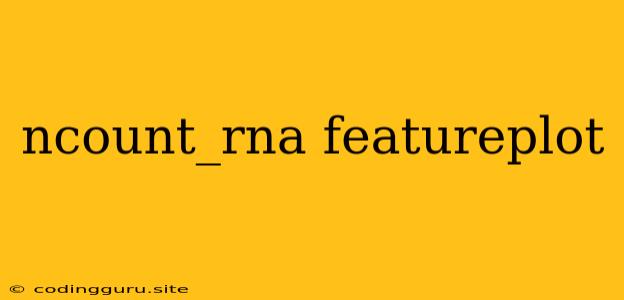Understanding ncount_rna and FeaturePlot in Single-Cell RNA Sequencing Analysis
Single-cell RNA sequencing (scRNA-seq) is a powerful technique that allows us to study gene expression at the individual cell level. This technology has revolutionized our understanding of cellular heterogeneity and provided valuable insights into various biological processes. To analyze and interpret scRNA-seq data effectively, we rely on various tools and visualization methods, two of which are ncount_rna and FeaturePlot.
What is ncount_rna?
ncount_rna is a metric commonly used in scRNA-seq analysis. It represents the total number of RNA transcripts detected in each cell. This information is crucial for several reasons:
- Quality Control:
ncount_rnacan be used to identify cells with low RNA content, which might be due to poor cell lysis, low RNA quality, or technical errors during library preparation. These cells are often excluded from further analysis to ensure data integrity. - Normalization:
ncount_rnais essential for normalizing gene expression data. Different cells can have varying amounts of total RNA, making direct comparison of gene expression levels across cells challenging. Normalization methods, such as CPM (counts per million) or TPM (transcripts per million), usencount_rnato adjust for differences in RNA content, allowing for a more accurate comparison of gene expression across cells. - Cell Type Identification: The
ncount_rnacan sometimes be used to distinguish cell types. For example, cells with higherncount_rnamight be actively dividing cells with a higher rate of transcription.
What is FeaturePlot?
FeaturePlot is a powerful visualization tool used in scRNA-seq analysis. It allows you to visualize the expression of a specific gene or feature across all cells in your dataset. This visualization helps you understand the distribution of gene expression across different cell types and identify cell subpopulations that exhibit high or low expression of a particular gene.
How does FeaturePlot work?
FeaturePlot typically uses a heat map or scatter plot to represent the expression of a chosen feature. Each cell is represented as a point, and the color of the point reflects the expression level of the chosen feature.
Example:
Imagine we want to visualize the expression of the gene IL6 (Interleukin 6) across all cells in our dataset. A FeaturePlot would display each cell as a point, with the color of the point representing the expression level of IL6. Cells with high IL6 expression would be colored in red, while cells with low expression would be colored in blue. This visualization allows us to easily identify cells with high IL6 expression and potentially identify cell types or states associated with increased IL6 production.
The Relationship Between ncount_rna and FeaturePlot
ncount_rna and FeaturePlot are often used together to gain deeper insights into scRNA-seq data. For instance, you can use ncount_rna to filter out cells with low RNA content before generating a FeaturePlot. This can help remove spurious signals and ensure that the FeaturePlot accurately represents the expression patterns of the chosen feature.
Furthermore, you can use ncount_rna in conjunction with FeaturePlot to understand the relationship between gene expression and cell size or RNA content. For example, you can visualize the expression of a gene against ncount_rna to see if there is a correlation between gene expression and the total RNA content of the cell.
How to Create FeaturePlot in R
Let's assume you have a Seurat object named seurat_object containing your scRNA-seq data. The following R code illustrates how to create a FeaturePlot using the Seurat package:
FeaturePlot(seurat_object, features = c("IL6", "TNF", "IFNG"), pt.size = 2)
This code will create a FeaturePlot for three genes: IL6, TNF, and IFNG. The pt.size argument sets the size of each point in the plot.
Conclusion
ncount_rna and FeaturePlot are powerful tools for analyzing and visualizing scRNA-seq data. By understanding how to use these tools effectively, researchers can gain valuable insights into the complex gene expression patterns observed in single-cell experiments. ncount_rna helps ensure data quality and enables normalization, while FeaturePlot allows us to visualize gene expression across cells and identify cell populations with unique expression patterns. This combination provides a powerful framework for dissecting cellular heterogeneity and unraveling the intricate regulatory mechanisms underlying cellular function.
